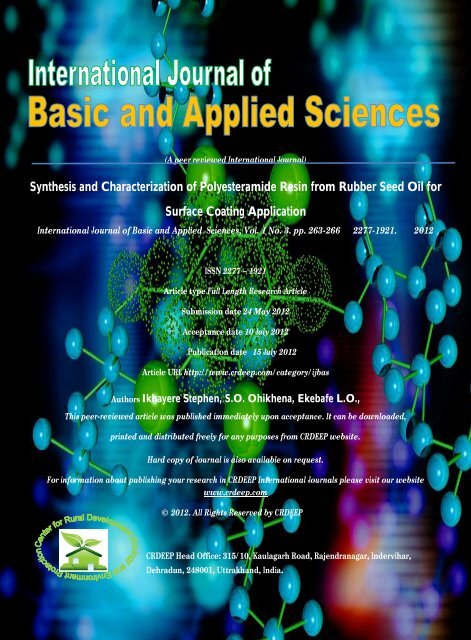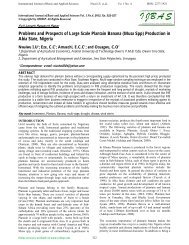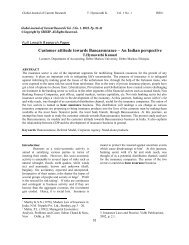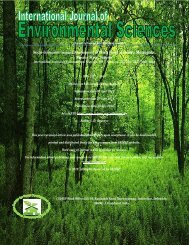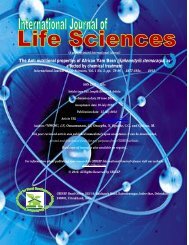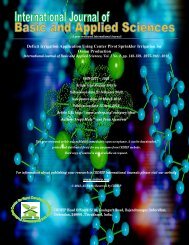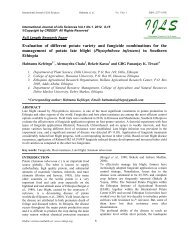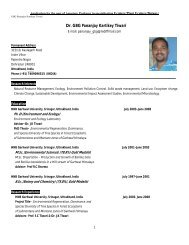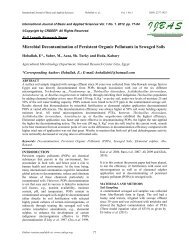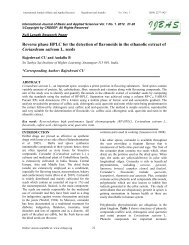Download Pdf - CRDEEP
Download Pdf - CRDEEP
Download Pdf - CRDEEP
Create successful ePaper yourself
Turn your PDF publications into a flip-book with our unique Google optimized e-Paper software.
International Journal of Basic and Applied Sciences Omorogbe et.al, Vol. 1 No. 3 ISSN: 2277-1921<br />
(A peer reviewed International Journal)<br />
Synthesis and Characterization of Polyesteramide Resin from Rubber Seed Oil for<br />
Surface Coating Application<br />
International Journal of Basic and Applied Sciences, Vol. 1 No. 3. pp. 263-266 2277-1921. 2012<br />
ISSN 2277 – 1921<br />
Article type Full Length Research Article<br />
Submission date 24 May 2012<br />
Acceptance date 10 July 2012<br />
Publication date 15 July 2012<br />
Article URL http://www.crdeep.com/category/ijbas<br />
Authors Ikhayere Stephen, S.O. Ohikhena, Ekebafe L.O.,<br />
This peer-reviewed article was published immediately upon acceptance. It can be downloaded,<br />
printed and distributed freely for any purposes from <strong>CRDEEP</strong> website.<br />
Hard copy of Journal is also available on request.<br />
For information about publishing your research in <strong>CRDEEP</strong> International Journals please visit our website<br />
www.crdeep.com<br />
© 2012. All Rights Reserved by <strong>CRDEEP</strong><br />
<strong>CRDEEP</strong> Head Office: 315/10, Kaulagarh Road, Rajendranagar, Indervihar,<br />
Dehradun, 248001, Uttrakhand, India.
International Journal of Basic and Applied Sciences Ikhayere et. .al, Vol. 1 No. 3 ISSN: 2277-1921<br />
International Journal of Basic and Applied Sciences Vol.1 No.3. 2012. Pp. 263- 266<br />
©Copyright by <strong>CRDEEP</strong>. All Rights Reserved<br />
Full Length Research Paper<br />
Synthesis and Characterization of Polyesteramide Resin from Rubber Seed Oil for<br />
Surface Coating Application<br />
Ikhayere Stephen 1 *, S.O. Ohikhena 2 , Ekebafe 1 L.O.,<br />
1<br />
Department of Polymer Technology, Auchi Polytechnic, Auchi, Edo State Nigeria<br />
Department of Chemical Engineering Technology, Auchi Polytechnic, P.M.B. 13, Auchi, Nigeria<br />
*Corresponding Author: khasteve019@yahoo.com<br />
Abstract<br />
The polyesteramide resin was synthesized from adipic acid, N,N-bis-(2-hydroxyethyl) and Hevea brasiliensis. Fatty amide was obtained<br />
from methyl ester of the rubber seed oil by treatment with diethanol amine. The synthesized intermediates and resin were characterized<br />
in terms of acid value, iodine value, saponification value, drying time and specific gravity. The coating performance of the resins was<br />
tested by measurement of pencil hardness, adhesion and chemical resistance. The polyesteramide resin has lower saponification value<br />
than the oil. The lower iodine value of the polyesteramide resin is obviously due to the reduction of the molecular mass of the oil which<br />
accommodates the unsaturation present in the fatty acids of the oil. The resin has a short set to touch time but a considerably long dry<br />
through time of 5 hours, the oil is probably a semi drying oil rather than a none drying or drying oil.<br />
Keywords: Rubber seed oil, Polyesteramide resin, Surface coating, triglycerides, curing<br />
Introduction<br />
Polyesteramide resins are products of poly-condensation<br />
reaction between polybasic acid polyhydric alcohols modified<br />
with fatty acid or drying oil. Oil modified polyhydric<br />
polyesteramide resin constitute a major group of resin used as<br />
blinders in surface coatings. It is estimated that polyester<br />
amide resins contribute about 70% to the conventional binders<br />
used in surface coating today .(1) The popularity of<br />
polyesteramide as vehicle for coatings is largely due to their<br />
unique properties such as film hardness, durability, gloss and<br />
gloss retention, resistance to abrasion etc. impacted on them<br />
through modification with drying oils. (2) The oils that are<br />
mostly employed for polyesteramide resins synthesis are<br />
linseed, soybean, castor, tall oils. (3) These oils are largely<br />
imported to Nigeria for the formulation of coatings for metal<br />
cans used in packing of beverages, drugs, food etc. however,<br />
drying oils are available locally, which have remained<br />
untapped. These include rubber seed oil, soybean oil, walnut<br />
oil and tobacco oil. (4) Rubber seed is obtained in high yield as<br />
a by-product of (Heavea-Brasiliensis) rubber tree cultivated<br />
primarily for its latex. (5) Further, it was also found that the<br />
kernels comprises 50% of the whole seed and yield 42.39%<br />
oil, these reports have eventually generated a lot of interest in<br />
the rubber seed across the world. (6) However, research has<br />
shown it be a rich source of oil that is comparable in quality to<br />
try oils commonly used in surfacing (7) .<br />
Online version available at: www.crdeep.com<br />
263<br />
Materials and Methods<br />
Materials<br />
Rubber Seed Oil was obtained from the Rubber Research<br />
Institute of Nigeria, Benin City, Xylene, Adipic Acid , Lead<br />
Mono-Oxide, Methyl-ethyl ketone Peroxide, Metallic<br />
Sodium, and Methanol , Anhydrous Sodium Sulfate, Ethanol,<br />
Potassium Hydroxide Sodium Thiosoulphate were supplied<br />
and are products of BDH, England. Styrene, and Diethanol<br />
Amine are products of Sigma-Aldrich, Germany<br />
Preparation of methylester of the oil<br />
Twenty five grams of oil in 50ml super dry methanol and<br />
0.5% sodium methoxide (with respect to the oil) were refluxed<br />
for 3hrs in 250ml round bottom flask in air. The content of<br />
flask were then cooled to room temperature and kept<br />
overnight. The excess methanol was removed by distillation<br />
and the methyl esters were extracted by petroleum ester (b.p.<br />
60-80 o c), washed with 15% aqueous NaCl solution and dried<br />
over anhydrous sodium sulfate. The methyl esters of the<br />
mixed fatty acids were purified from ester by distillation.<br />
Quantitative yield of the product was obtained.<br />
Preparation of diethanol amide from the methylester of the<br />
oil<br />
A three-necked round bottom flask equipped with a<br />
mechanical stirrer,and a dropping funnel were used for the<br />
preparation for the diethanol amide of the esters. 3.45g<br />
diethanol amine and 0.5% sodium methoxide (with respect to<br />
the ester) were taken in the flask with constant stirring under<br />
the presence of air and heated to 110-115 o C, then the methyl
International Journal of Basic and Applied Sciences Ikhayere et. .al, Vol. 1 No. 3 ISSN: 2277-1921<br />
esters of the oil were added into reaction mixture dropwise<br />
through the dropping funnel over a period of 1hr. The heating<br />
continued for another 3hr with constant stirring. Then the<br />
reaction mixture was cooled to room temperature, dissolved in<br />
petroleum ether, washed with 15% aqueous NaCl solution and<br />
dried over anhydrous sodium sulfate. The petroleum ester was<br />
removed by distillation to yield N,N’-bis(2-hydroxyethyl)<br />
rubber seed oil amide (diethanol amide of the fatty acids).<br />
The yield was ≈80%.<br />
Preparation of polyesteramide from diethanol<br />
Amide of the fatty acids and dibasic acid or its derivatives<br />
0.08 mole (29.1g) of the amides of the fatty acids with 0.6% of<br />
PbO (with respect to the amide) were taken in a three-necked<br />
round bottom flask with the same arrangement as described<br />
earlier under the presence of air with constant stirring. The<br />
mixture was heated to 120-125 o C and 0.08 mole of diacid<br />
(11.68g adipic acid) was added into the mixture with 50mL<br />
xylene to facilitate the mixing of the reactants. Then it was<br />
heated to 180-190 o C for 2.5-3.5hrs and cooled to room<br />
RESULTS AND DISCUSSION<br />
Rubber seed oil analysis<br />
Table 1. Results of rubber seed oil analysis<br />
Online version available at: www.crdeep.com<br />
temperature. The reaction was monitored by acid value<br />
determination of the viscous product. The yield was found to<br />
be very high (80-90%).<br />
Curing of Resins<br />
A homogenous mixture of resins with 30 phr of styrene as the<br />
reactive diluents, 4 phr of MEKP (methyl-ehtyl ketone<br />
peroxide) as initiator was prepared in a glass beaker at room<br />
temperature by hand stirring for 10min (phr=parts per hundred<br />
gram of resin). The plates (glass/mild steel) were uniformly<br />
coated by the respective resin into a thin film and heated in an<br />
oven at a definite temperature for specified period of time.<br />
Characterization of polyesteramide resin<br />
The physic-chemical properties of the polyesteramide resin<br />
samples (colour, specific gravity acide value sanponification<br />
value, iodine value) where determined according to ASTM<br />
standard methods (8, 9, 10) . The FTIR analysis was carried out to<br />
confirm changes in the structure of the rubber seed oil to the<br />
formation of the resin as shown in Figure 1.<br />
Property Rubber seed<br />
Polyester amide<br />
oil<br />
resin<br />
Specific Gravity (KG/m 3 ) 0.92992 0.9566<br />
Acid Value (mol.dm 3 ) 27.300 25.90<br />
Saponification Value<br />
(mg/g)<br />
191.52 126.16<br />
Iodine Value (mmol/kg) 145.8021 109.0470<br />
Colour Golden colour Dark brown<br />
The properties of rubber seed oil extracted and the<br />
polyesteramide resin produced from it are provided in table 1.<br />
As expected of any given oil, the rubber seed oil has a lower<br />
density than that of water (1g /cm 3 ). The high values of the<br />
saponification and iodine values of the oil can respectively be<br />
attributed to the presence of esters linkages and the level of<br />
unsaturated in the oil.<br />
The polyesteramide resin has a much lower saponification<br />
value than the oil. The lower iodine value of the<br />
polyesteramide resin is most likely due to the reduction of the<br />
molecular mass of the oil which accommodates the<br />
unsaturation present in the fatty acids of the oil.<br />
Polyesteramide resin analysis<br />
Table 2. Result of polyesteramide analysis<br />
Drying schedule Time (mins)<br />
Set to touch 16<br />
Surface dry 45<br />
Dry through 300<br />
Property Resin observation<br />
Pencil hardness HB pass<br />
Adhesion Fair<br />
Solvent medium Visual observation<br />
Distilled water (cold) Excellent<br />
Salt (15% Nacl) Excellent<br />
Alkali (10% KOH) Poor<br />
Acids (0.5 Hcl) Excellent<br />
264
International Journal of Basic and Applied Sciences Ikhayere et. .al, Vol. 1 No. 3 ISSN: 2277-1921<br />
Figure 1: FTIR diagram of the polyesteramide resin<br />
Figure 2: Structure of the FTIR for the rubber seed oil<br />
The dry schedule of the polyesteramide resins are as<br />
presented in table.2. The resin has a short set to<br />
touch time but a considerably long dry through time<br />
of 5 hours, the oil is probably a semi drying oil rather<br />
than a none drying or drying oil.<br />
The chemical resistances of polyesteramide resin as<br />
evaluated in different solvent medium are presented<br />
in Table 2. The polyesteramide resin film was found<br />
to resist water, salt and acid medium but poor. The<br />
poor observation when in alkali medium may be due<br />
to the susceptibility of polyesters to<br />
hydrolysis. Adhesion is relatively fair as film former<br />
retain some measurement of tackiness.<br />
Online version available at: www.crdeep.com<br />
265<br />
The FTIR analysis show remarkable changes in the<br />
functional group of the initial starting material, the<br />
rubber seed oil leading to the introduction of the ester<br />
and amide functional groups as seen in the resin<br />
FTIR spectrum in Fig 1<br />
Conclusion<br />
From this study,the renewable rubber seed oil has<br />
been utilized successfully for the synthesis of the<br />
industrial polyesteramide resins. The resins were<br />
successfully characterized by the determination of<br />
physical properties showing good adhesion, hardness<br />
and chemical resistance properties which make them
International Journal of Basic and Applied Sciences Ikhayere et. .al, Vol. 1 No. 3 ISSN: 2277-1921<br />
suitable for surface coating, and binder for<br />
composite,<br />
References<br />
1. M. BAJPAI, S. SETH. “Use of unconventional Oils<br />
Surface Coating: Blends of Alkyd Resin with Epoxy<br />
Ester. Pigment and Resins Technology; Second<br />
Edition Vol.29, 2000, pages 82-87<br />
2. A.I, AIGBODION “Preliminary Studies on the<br />
preparation of Rubber Seed Oil”. Indian J natur<br />
Rubber Res second Edition 1991,Vol. 4 page 144-70.<br />
3. S. MAJUNDER. D. KUMAR,, Y.P.S NIRYAN,<br />
“Acrylate Grafted Dehydrated Castor Oil Alkyd. A<br />
Binder for Exterior Paints” Indian 1999, Vol. 60 page<br />
57-65<br />
4. Adefarati, FB “Development of Non-Edible Oils for<br />
use in the Nigeria Surface Coating Industry with<br />
particular Reference to Rubber (Hevea Brasillensis)<br />
Seed Oil for Manufacture of Air-Drying Oil” Modified<br />
Akyds 1986, Pages 27-38<br />
Online version available at: www.crdeep.com<br />
266<br />
5. H.B.KIM, N.A. WINNINK “Effect of surface acid<br />
Group Neutralization on Rubber Latex Films<br />
Macromolecules” 1994, Vol. 27 page 1007-12.<br />
6. A.I.AIGBODION, PILLAICKS “Preparation Analysis<br />
and Applications of Rubber Seed Oil and its<br />
Derivatives in Surface Coating”. Progress in organic<br />
2000, Vol. 38 page 187-92.<br />
7. F.E.OKEIMEN, C.O. OKIEIMEN “Utilization of<br />
Vegetable Oils as Alternative Diesel Fuel. A Review”.<br />
Nigeria Journal applied science , 2002,Vol. 18 page<br />
102-8.<br />
8. ASTMD 1639-90, Standard Method for Acid Value of<br />
Organic Materials”. Annual book of American society<br />
for testing and material standards Philadelphia, PA,<br />
1994; 06.01:260-1.<br />
9. ASTM D 1962-67 “Test for saponification value of<br />
drying oil, fats and polymerized fatty acids”, annual<br />
book of American society for testing and material<br />
standards. Philadelphia, PA, (1979) 29:259-61.<br />
10. ASTM D 1959-69, “Test for lodine value of drying Oils<br />
and their Derivatives”, Annual book of American society<br />
for testing and material standards. Philadelphia, PA,<br />
1979:29:265-7
International Journal of Basic and Applied Sciences Omorogbe et.al, Vol. 1 No. 3 ISSN: 2277-1921


